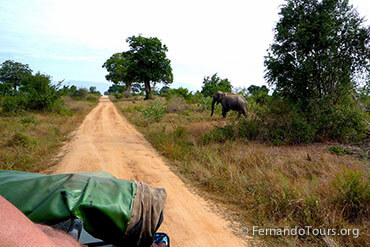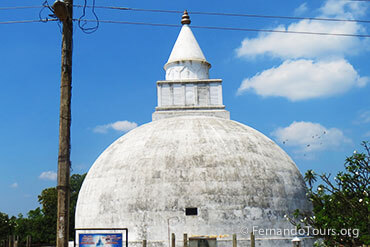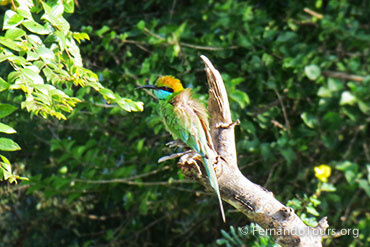
Wildlife & Nature
The Pinnawala Elephant Orphanage, nestled in the heart of Sri Lanka, is a captivating sanctuary dedicated to the care and conservation of elephants. Situated along the banks of the Maha Oya River, this orphanage has gained international acclaim for its efforts in rescuing, rehabilitating, and nurturing orphaned and injured elephants.
As you approach the orphanage, the sight of majestic elephants freely roaming and bathing in the river unfolds, creating a picturesque and heartwarming spectacle. The facility serves as a haven for these gentle giants, providing them with a safe and natural environment to thrive.
Visitors to Pinnawala Elephant Orphanage have the unique opportunity to observe the elephants up close during their daily routines. The highlight is the bathing ritual, where the elephants joyfully immerse themselves in the river, showcasing their playful and social nature. The experience fosters a deeper connection between humans and these incredible creatures, fostering awareness about the importance of elephant conservation.
Beyond its role in elephant care, the orphanage also serves as an educational center. Informative sessions and guided tours offer insights into elephant behavior, biology, and the challenges they face in the wild. The commitment to conservation is evident in the orphanage’s mission to release rehabilitated elephants back into their natural habitat.
The lush surroundings of Pinnawala Elephant Orphanage contribute to the serene atmosphere, making it an ideal place for both education and relaxation. It stands as a testament to Sri Lanka’s dedication to wildlife preservation and the harmony between humans and elephants, providing a memorable and enriching experience for visitors from around the world.
Pinnawala Elephant Orphanage stands as one of Sri Lanka’s renowned sanctuaries for orphaned elephants. However, an equally noteworthy elephant orphanage exists in proximity to Udawalawe National Park known as The Elephant Transit Home. This sanctuary is distinctive in its mission, as it focuses on releasing young elephants back into the wild.
Please note there is an entrance fee to visit Pinnawala Elephant Orphanage.

Wildlife & Nature
Udawalawe National Park, located in the southern part of Sri Lanka, is a renowned wildlife sanctuary celebrated for its diverse flora and fauna, with a particular emphasis on elephants. Here are key features of Udawalawe National Park:
1. Elephant Population: Udawalawe is famous for its significant elephant population, and the park is considered one of the best places in Sri Lanka to observe these majestic creatures in their natural habitat. The park provides a crucial habitat for Sri Lankan elephants, and visitors often witness herds roaming freely.
2. Wildlife Safari: Safari tours in open-top jeeps are a popular way to explore Udawalawe National Park. During the safari, visitors have the opportunity to spot a variety of wildlife, including elephants, water buffaloes, crocodiles, deer, and a diverse range of bird species.
3. Udawalawe Reservoir: The park surrounds the Udawalawe Reservoir, which not only enhances the scenic beauty of the area but also serves as a crucial water source for the park’s wildlife. The reservoir attracts a variety of bird species, making it a haven for birdwatchers.
4. Bird Watching: Udawalawe is a paradise for bird enthusiasts, with over 200 bird species recorded in the park. Common sightings include peafowl, eagles, owls, herons, and many other migratory and resident bird species.
5. Nature Trails: Some areas within the park offer nature trails for those who prefer a more active way of exploring. These trails provide a closer look at the park’s vegetation and offer opportunities for observing smaller wildlife.
6. Conservation and Research: Udawalawe National Park is actively involved in conservation efforts, particularly regarding the protection of elephants. Researchers and conservationists study the park’s wildlife to better understand and protect its ecosystems.
7. Scenic Landscapes: In addition to its wildlife, Udawalawe offers picturesque landscapes with grasslands, scrub jungles, and the backdrop of the surrounding hills. The scenery adds to the overall safari experience.
8. The Elephant Transit Home: The Elephant Transit Home, located near Udawalawe National Park in Sri Lanka, is a unique rehabilitation center for orphaned elephants.
9. Accessibility: Udawalawe is easily accessible, making it a popular destination for both local and international tourists. The proximity to major cities and well-maintained roads contribute to its popularity.
Udawalawe National Park is not only a haven for wildlife enthusiasts but also plays a crucial role in the conservation of Sri Lanka’s natural heritage. The park offers a memorable and immersive experience for those seeking to witness the beauty of the island’s wildlife in a natural and protected environment.
Please be aware that there is an entrance fee required for access to Udawalawe National Park, in addition to expenses associated with hiring a jeep for your visit.

Wildlife & Nature
The Elephant Transit Home, located near Udawalawe National Park in Sri Lanka, is a unique rehabilitation center for orphaned elephants. Here are key features of The Elephant Transit Home:
1. Rescue and Rehabilitation: The primary purpose of The Elephant Transit Home is to rescue, rehabilitate, and release orphaned elephant calves back into the wild. Many of these calves have been orphaned due to various reasons, including human-wildlife conflict, accidents, or natural disasters.
2. Collaboration with the Department of Wildlife Conservation: The facility operates in collaboration with the Department of Wildlife Conservation in Sri Lanka. The ultimate goal is to reintegrate the rehabilitated elephants into their natural habitat.
3. Minimal Human Contact: The rehabilitation process at The Elephant Transit Home emphasizes minimal human contact to ensure that the elephants retain their wild instincts and behaviors. This approach increases the chances of successful reintroduction into the wild.
4. Feeding Program: The facility has a unique feeding program where milk is provided to the orphaned calves at regular intervals. The milk is delivered through a special feeding gate, minimizing direct interaction between the elephants and caretakers.
5. Observation Deck: Visitors to The Elephant Transit Home can observe the elephants from a designated viewing deck. The observation deck is strategically located to allow guests to witness the feeding sessions and the elephants’ behavior without causing any disturbance.
6. Release into Udawalawe National Park: Once the elephants reach an age and level of maturity suitable for survival in the wild, they are released into Udawalawe National Park. This process is gradual and allows the elephants to adapt to their natural environment.
7. Educational Initiatives: The facility also serves as an educational center, raising awareness about the conservation challenges faced by elephants in Sri Lanka. Visitors learn about the importance of protecting natural habitats and minimizing human-wildlife conflict.
8. Contribution to Conservation: The Elephant Transit Home plays a vital role in the broader conservation efforts for Sri Lankan elephants. By rescuing and rehabilitating orphaned elephants, the center contributes to the preservation of the species and the conservation of biodiversity.
Visiting The Elephant Transit Home provides a unique opportunity to witness the rehabilitation process of orphaned elephants and to support conservation initiatives. It is a place where the well-being of the elephants takes precedence, and the ultimate goal is to give them a second chance to thrive in their natural environment.
Please note that there is a small entrance fee to The Elephant Transit Home.

Towns & Cities
Tissamaharama (Tissa), is the ideal place to stay before a visit to the nearby Yala National Park and Bundala National Park.
The area around Tissa is home to a lot of birds and wildlife.

Wildlife & Nature
Yala National Park also called Ruhunu National Park, on the southeast coast of Sri Lanka, is one of Sri Lanka’s premier eco tourism destinations.
With tropical thorn forest and lagoons it is possible to spot wild elephants, sloth bears, water buffaloes, wild boars, monkeys, flamingos and if we are lucky we can see leopards too.
Yala National Park has the largest population of leopards in Sri Lanka.
A jeep safari is the only way to enter this national park.
The jeep safari begins either in the early morning before sun rise, or in the afternoon where the animals comes out of the bushes due to the falling temperature.
Best time to visit: Nov-Jul
Nearest town is Tissamaharama
Please note there is an entrance fee, and expenses for jeep hire.
Tips for jeep chauffeur and tracker are also not included in the tour price.




